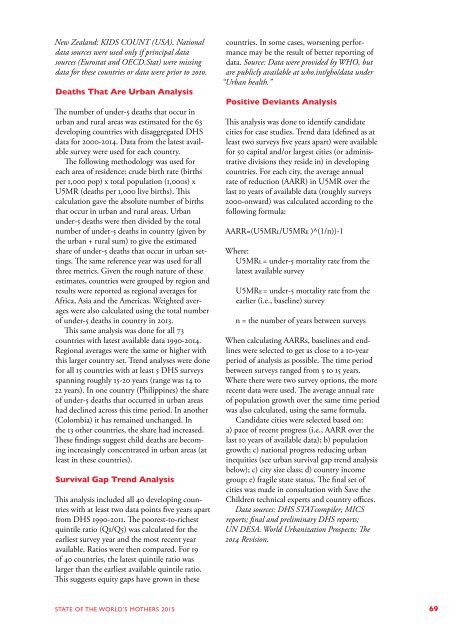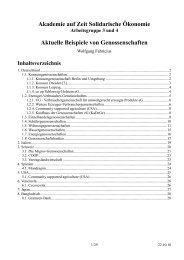sowm_2015__int__africa_full_report_low_res
sowm_2015__int__africa_full_report_low_res
sowm_2015__int__africa_full_report_low_res
You also want an ePaper? Increase the reach of your titles
YUMPU automatically turns print PDFs into web optimized ePapers that Google loves.
New Zealand; KIDS COUNT (USA). National<br />
data sources were used only if principal data<br />
sources (Eurostat and OECD.Stat) were missing<br />
data for these countries or data were prior to 2010.<br />
Deaths That Are Urban Analysis<br />
The number of under-5 deaths that occur in<br />
urban and rural areas was estimated for the 63<br />
developing countries with disaggregated DHS<br />
data for 2000-2014. Data from the latest available<br />
survey were used for each country.<br />
The fol<strong>low</strong>ing methodology was used for<br />
each area of <strong>res</strong>idence: crude birth rate (births<br />
per 1,000 pop) x total population (1,000s) x<br />
U5MR (deaths per 1,000 live births). This<br />
calculation gave the absolute number of births<br />
that occur in urban and rural areas. Urban<br />
under-5 deaths were then divided by the total<br />
number of under-5 deaths in country (given by<br />
the urban + rural sum) to give the estimated<br />
share of under-5 deaths that occur in urban settings.<br />
The same reference year was used for all<br />
three metrics. Given the rough nature of these<br />
estimates, countries were grouped by region and<br />
<strong>res</strong>ults were <strong>report</strong>ed as regional averages for<br />
Africa, Asia and the Americas. Weighted averages<br />
were also calculated using the total number<br />
of under-5 deaths in country in 2013.<br />
This same analysis was done for all 73<br />
countries with latest available data 1990-2014.<br />
Regional averages were the same or higher with<br />
this larger country set. Trend analyses were done<br />
for all 15 countries with at least 5 DHS surveys<br />
spanning roughly 15-20 years (range was 14 to<br />
22 years). In one country (Philippines) the share<br />
of under-5 deaths that occurred in urban areas<br />
had declined across this time period. In another<br />
(Colombia) it has remained unchanged. In<br />
the 13 other countries, the share had increased.<br />
These findings suggest child deaths are becoming<br />
increasingly concentrated in urban areas (at<br />
least in these countries).<br />
Survival Gap Trend Analysis<br />
This analysis included all 40 developing countries<br />
with at least two data po<strong>int</strong>s five years apart<br />
from DHS 1990-2011. The poo<strong>res</strong>t-to-richest<br />
qu<strong>int</strong>ile ratio (Q1/Q5) was calculated for the<br />
earliest survey year and the most recent year<br />
available. Ratios were then compared. For 19<br />
of 40 countries, the latest qu<strong>int</strong>ile ratio was<br />
larger than the earliest available qu<strong>int</strong>ile ratio.<br />
This suggests equity gaps have grown in these<br />
countries. In some cases, worsening performance<br />
may be the <strong>res</strong>ult of better <strong>report</strong>ing of<br />
data. Source: Data were provided by WHO, but<br />
are publicly available at who.<strong>int</strong>/gho/data under<br />
“Urban health.”<br />
Positive Deviants Analysis<br />
This analysis was done to identify candidate<br />
cities for case studies. Trend data (defined as at<br />
least two surveys five years apart) were available<br />
for 50 capital and/or largest cities (or administrative<br />
divisions they <strong>res</strong>ide in) in developing<br />
countries. For each city, the average annual<br />
rate of reduction (AARR) in U5MR over the<br />
last 10 years of available data (roughly surveys<br />
2000-onward) was calculated according to the<br />
fol<strong>low</strong>ing formula:<br />
AARR=(U5MRL/U5MRE )^(1/n))-1<br />
Where:<br />
U5MRL = under-5 mortality rate from the<br />
latest available survey<br />
U5MRE = under-5 mortality rate from the<br />
earlier (i.e., baseline) survey<br />
n = the number of years between surveys<br />
When calculating AARRs, baselines and endlines<br />
were selected to get as close to a 10-year<br />
period of analysis as possible. The time period<br />
between surveys ranged from 5 to 15 years.<br />
Where there were two survey options, the more<br />
recent data were used. The average annual rate<br />
of population growth over the same time period<br />
was also calculated, using the same formula.<br />
Candidate cities were selected based on:<br />
a) pace of recent prog<strong>res</strong>s (i.e., AARR over the<br />
last 10 years of available data); b) population<br />
growth; c) national prog<strong>res</strong>s reducing urban<br />
inequities (see urban survival gap trend analysis<br />
be<strong>low</strong>); c) city size class; d) country income<br />
group; e) fragile state status. The final set of<br />
cities was made in consultation with Save the<br />
Children technical experts and country offices.<br />
Data sources: DHS STATcompiler; MICS<br />
<strong>report</strong>s; final and preliminary DHS <strong>report</strong>s;<br />
UN DESA. World Urbanization Prospects: The<br />
2014 Revision.<br />
STATE OF THE WORLD’S MOTHERS <strong>2015</strong> 69




